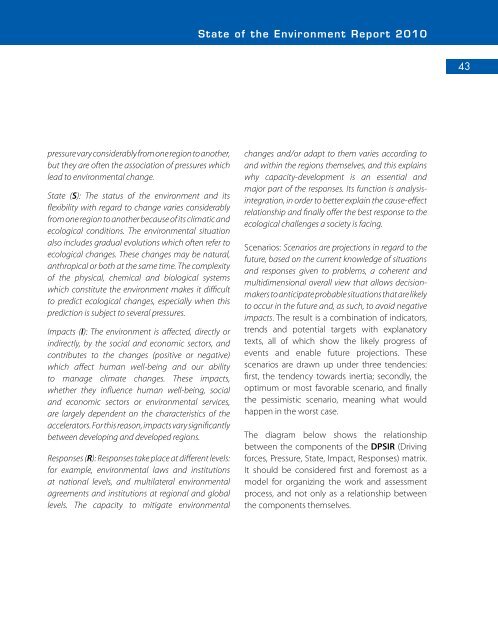GEO Haiti 2010
GEO Haiti 2010
GEO Haiti 2010
Create successful ePaper yourself
Turn your PDF publications into a flip-book with our unique Google optimized e-Paper software.
State of the Environment Report <strong>2010</strong><br />
43<br />
pressure vary considerably from one region to another,<br />
but they are often the association of pressures which<br />
lead to environmental change.<br />
State (S): The status of the environment and its<br />
flexibility with regard to change varies considerably<br />
from one region to another because of its climatic and<br />
ecological conditions. The environmental situation<br />
also includes gradual evolutions which often refer to<br />
ecological changes. These changes may be natural,<br />
anthropical or both at the same time. The complexity<br />
of the physical, chemical and biological systems<br />
which constitute the environment makes it difficult<br />
to predict ecological changes, especially when this<br />
prediction is subject to several pressures.<br />
Impacts (I): The environment is affected, directly or<br />
indirectly, by the social and economic sectors, and<br />
contributes to the changes (positive or negative)<br />
which affect human well-being and our ability<br />
to manage climate changes. These impacts,<br />
whether they influence human well-being, social<br />
and economic sectors or environmental services,<br />
are largely dependent on the characteristics of the<br />
accelerators. For this reason, impacts vary significantly<br />
between developing and developed regions.<br />
Responses (R): Responses take place at different levels:<br />
for example, environmental laws and institutions<br />
at national levels, and multilateral environmental<br />
agreements and institutions at regional and global<br />
levels. The capacity to mitigate environmental<br />
changes and/or adapt to them varies according to<br />
and within the regions themselves, and this explains<br />
why capacity-development is an essential and<br />
major part of the responses. Its function is analysisintegration,<br />
in order to better explain the cause-effect<br />
relationship and finally offer the best response to the<br />
ecological challenges a society is facing.<br />
Scenarios: Scenarios are projections in regard to the<br />
future, based on the current knowledge of situations<br />
and responses given to problems, a coherent and<br />
multidimensional overall view that allows decisionmakers<br />
to anticipate probable situations that are likely<br />
to occur in the future and, as such, to avoid negative<br />
impacts. The result is a combination of indicators,<br />
trends and potential targets with explanatory<br />
texts, all of which show the likely progress of<br />
events and enable future projections. These<br />
scenarios are drawn up under three tendencies:<br />
first, the tendency towards inertia; secondly, the<br />
optimum or most favorable scenario, and finally<br />
the pessimistic scenario, meaning what would<br />
happen in the worst case.<br />
The diagram below shows the relationship<br />
between the components of the DPSIR (Driving<br />
forces, Pressure, State, Impact, Responses) matrix.<br />
It should be considered first and foremost as a<br />
model for organizing the work and assessment<br />
process, and not only as a relationship between<br />
the components themselves.

















